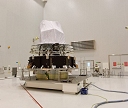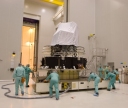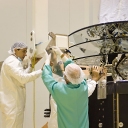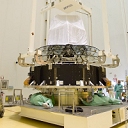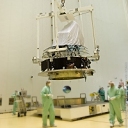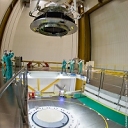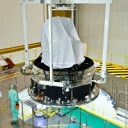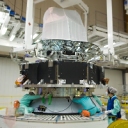Planck mated with the Ariane 5 ECA launcher
29 April 2009
This is the final entry in the Planck Launch Campaign journal series, which ran from February 2009 until just before launch in May 2009. The journal covered the main activities during the period leading up to launch: from the shipment of the spacecraft to the launch site in Kourou, to the final integration of the spacecraft with the launcher. This journal series followed the Planck Test Campaign journal series, which ran from September 2005 to November 2008 (see link in right-hand menu). The Planck spacecraft has been mated with the Ariane 5 ECA launcher on 23 April 2009. After the successful fuelling of the Planck spacecraft in the S5A building a week earlier, the spacecraft was transferred to the final assembly building (Bâtiment d'Assemblage Final, or BAF) in the evening on 22 April. There it has been integrated on top of the launcher rocket that will place both the Planck and the Herschel spacecraft in their trajectories to L2.Move to the final assembly building
The BAF building is dedicated to final preparation of the launcher on the launch table, integration of the upper composite (SYLDA 5 support structure and fairing), and assembly of the upper composite on top of the launcher. The building is located about 10 km from the S5A building where the Planck fuelling operations were performed and about 2.6 km from the Ariane launch pad.
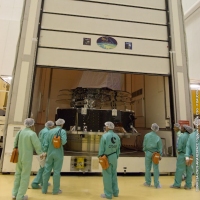 |
|
Opening of the CCU3 container inside the BAF, 23 April 2009. |
In parallel to the spacecraft preparation activities during the launch campaign, the lower part of the Ariane 5 ECA launcher has also been assembled and prepared. Now standing in the 90m-high hall of the BAF building it is comprised of the main cryogenic core stage (EPC) and the two solid propellant boosters on opposite sides of the EPC. On top of the EPC are the upper stage (ESCA) and finally the Vehicle Equipment Bay (VEB). A 0.78m-high adapter cone, composed of a strong carbon structure and two aluminium rings, is integrated over the VEB to interface between the launcher and the Planck spacecraft.
Planck mating with launcher
The 47m-high BAF airlock is adjacent to the BAF's 90m-high hall where launchers are mated with their payload and are finalised. The airlock and the adjacent hall are connected by a wide shaft in the hall that at its base opens into the airlock.
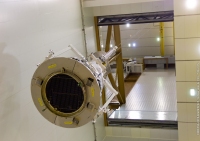 |
|
The Planck spacecraft is lifted up inside the BAF, 23 April 2009. |
Inside the hall the spacecraft was manoeuvred over the Ariane launcher. It was then lowered in place and integrated with the launcher by personnel on the payload access platform (Plate-Forme Charge Utile, or PFCU), which surrounds the launcher at the height of the VEB. The ACU was bolted to the launcher's adapter cone that is secured on the VEB. The electrical connections between the launcher and the ACU were also set up and tested.
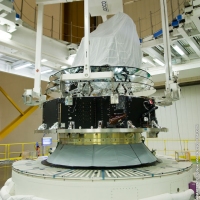 |
Image on the right: Planck is mated with the launcher.
Credit: ESA-CNES-Arianespace / Optique Vidéo du CSG - P. Baudon
Final preparations were then performed on the Planck spacecraft before its encapsulation with the SYLDA 5 support structure that will carry the Herschel spacecraft during the joint launch. These preparations included the last finalisation of the multi-layer insulation, the removal of all non-flight items such as protective covers, and a final visual inspection of the spacecraft. The Planck spacecraft was also switched on for a final functional check after the mating with the launcher.
SYLDA 5 integration on launcher
The SYLDA 5 (Système de Lancement Double Ariane) is a support structure that can be used during joint launches on an Ariane 5 launcher to carry the upper part of the launcher's payload, the second spacecraft. It consists of a load bearing carbon structure that is comprised of a conical base fixed to the Vehicle Equipment Bay, a high cylindrical shell and an upper truncated conical shell.
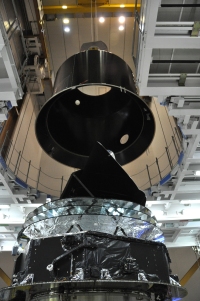 |
|
Lowering of the SYLDA 5 over the Planck spacecraft, 27 April 2009. |
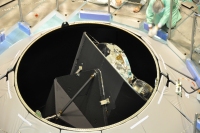 |
|
Overhead view of the SYLDA 5 after encapsulation, 27 April 2009. |
The base of the SYLDA 5 is bolted to the VEB. After launch, at the required time, a pyrotechnical device running around the SYLDA 5 at the level of the conical/cylindrical lower interface will cut it in a horizontal plane. Immediately after, springs will impart an impulse to jettison the SYLDA 5 away from the spacecraft.
After its installation on the Ariane 5 ECA launcher the SYLDA 5's electrical connections with the launcher were set up and verified. To maintain the Planck spacecraft's environment under the enclosing support structure a nitrogen flushing system has been connected to the SYLDA 5, providing dry nitrogen atmosphere to Planck.
The next major milestone in the launch campaign will be the mating of the Herschel spacecraft on top of the SYLDA 5.

